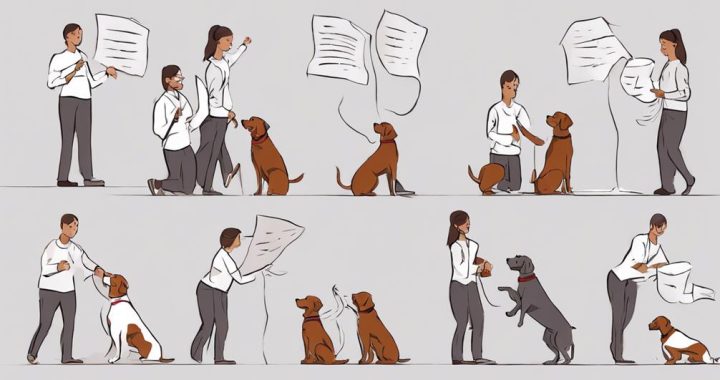Utilizing obedience training scripts in role-playing scenarios is crucial for providing structure and clarity, enhancing message consistency, fostering teamwork, and ensuring efficiency in training sessions. These scripts establish clear guidelines, maintain a structured environment, and enhance the learning experience for participants. By incorporating interactive elements, promoting collaboration, and reinforcing desired behaviors, these scripts not only improve obedience skills but also create a dynamic and engaging atmosphere. Additionally, prioritizing safety measures and controlling the environment are vital aspects that contribute to successful outcomes. It's important to recognize the value of obedience training scripts in maximizing the effectiveness of role-playing scenarios.
Benefits of Using Scripts

Utilizing scripts in obedience training scenarios offers a structured framework that enhances consistency and clarity in communication between participants. By having predetermined dialogues and responses, scripts increase the effectiveness of training sessions by ensuring that key messages are delivered consistently. This consistency helps dogs understand commands better as they're repeated in a uniform manner.
Moreover, scripts promote teamwork among participants by providing a common language and approach to training. When everyone follows the same script, there's a shared understanding of the goals and methods used in the training process, fostering a sense of unity and collaboration.
In addition to promoting teamwork, scripts also help streamline the training process by reducing ambiguity and confusion. Clear, scripted instructions leave little room for interpretation, ensuring that both humans and dogs are on the same page throughout the training session. This clarity ultimately leads to more efficient and productive training sessions, as participants can focus on executing the tasks at hand rather than deliberating over what needs to be done.
Establishing Clear Guidelines
Implementing clear guidelines is foundational for effective communication and consistency in obedience training scenarios. By setting boundaries, you establish the framework within which the role-playing interactions will occur. These boundaries serve as a roadmap for participants, guiding their behavior and responses. When individuals understand the limits and expectations, it fosters discipline and reinforces the desired behaviors.
Clear guidelines also help in maintaining a structured environment during the role-playing sessions. They provide a sense of security for participants, knowing what's expected of them and how they should act in various scenarios. Consistency in enforcing these guidelines is crucial for reinforcing obedience training principles. When participants see that the rules are consistently applied, it reinforces the importance of following instructions promptly and accurately.
Furthermore, setting clear guidelines enhances the overall learning experience by creating a focused and controlled environment. Participants can concentrate on the specific behaviors being addressed, leading to more effective learning and retention of training concepts.
In essence, establishing clear guidelines is the cornerstone of successful obedience training role-playing scenarios.
Enhancing Role-play Experience

To elevate the role-play experience in obedience training scenarios, consider incorporating interactive elements that engage participants on multiple levels. Increasing immersion through interactive storytelling can make the experience more engaging and realistic.
By immersing participants in a scenario where they must communicate effectively to succeed, their communication skills are put to the test in a practical and hands-on way. This not only enhances their understanding of obedience training concepts but also improves their ability to convey commands clearly and assertively.
Furthermore, incorporating team dynamics into the role-play scenarios can foster collaboration and problem-solving skills among participants. Encouraging individuals to work together towards a common goal not only mirrors real-life obedience training situations but also promotes a sense of camaraderie and unity within the group.
This collaborative aspect can enhance the overall experience by creating a more dynamic and interactive environment that challenges participants to think on their feet and adapt to different scenarios effectively.
Improving Obedience Skills
Enhancing obedience skills requires consistent practice and reinforcement of desired behaviors through structured training methods. To improve obedience skills effectively, focus on enhancing communication between the trainer and trainee. Clear and concise communication is crucial in conveying expectations and commands.
Interactive learning plays a significant role in obedience training, as it engages the trainee actively in the learning process. By incorporating interactive elements such as games, puzzles, or role-playing scenarios, you can make obedience training more engaging and enjoyable for the trainee. These methods not only make the learning process more interactive but also help reinforce desired behaviors effectively.
Additionally, interactive learning promotes better retention of training concepts and commands.
Reinforcing Desired Behaviors

Consistent reinforcement of desired behaviors is key to solidifying obedience skills in training scenarios. Behavior modification techniques focus on encouraging positive behaviors through the use of positive reinforcement. Positive reinforcement involves rewarding the individual when they exhibit the desired behavior, increasing the likelihood of that behavior being repeated in the future. This method is highly effective in obedience training as it helps individuals understand which behaviors are correct and desirable.
In obedience training scripts for role-playing scenarios, reinforcing desired behaviors plays a crucial role. By consistently rewarding the individual for following instructions correctly or demonstrating the desired behavior, you're actively shaping their responses and attitudes. This positive reinforcement helps in establishing a clear connection between the action and the reward, making it more likely for the individual to remember and repeat the behavior in the future.
Incorporating positive reinforcement into obedience training scripts ensures that individuals not only learn the correct behaviors but also feel motivated and encouraged to continue exhibiting those behaviors. By reinforcing desired actions consistently, you're actively shaping their responses and fostering a positive learning environment.
Building Confidence and Consistency
Establishing a foundation of confidence and consistency is essential in obedience training scripts for role-playing scenarios. Confidence building is crucial as it helps the participants feel secure in their roles, enabling them to embody the desired behaviors more effectively. By instilling confidence through positive reinforcement and encouragement, individuals are more likely to engage in the training process with enthusiasm and openness.
Consistency reinforcement is another key aspect of obedience training scripts. It involves setting clear expectations and boundaries to ensure that the behaviors being practiced are consistently reinforced throughout the scenarios. Consistency helps create a sense of structure and reliability, allowing participants to understand what's expected of them and how to respond in different situations.
Incorporating confidence-building techniques and consistency reinforcement strategies into obedience training scripts not only enhances the effectiveness of the role-playing scenarios but also contributes to the overall success of the training program. By focusing on these elements, participants can develop the skills and mindset necessary for mastering the desired behaviors in a controlled and supportive environment.
Creating Safe and Controlled Environment

To foster optimal learning and behavior modification, ensuring a safe and controlled environment is paramount in obedience training scripts for role-playing scenarios. Safety measures play a crucial role in creating an environment where participants can focus on learning and practicing without fear of harm. Incorporating safety protocols such as setting boundaries, using appropriate equipment, and having trained supervisors present can help maintain a controlled setting.
By implementing safety measures, obedience training scripts can effectively teach and reinforce desired behaviors. A controlled setting allows participants to feel secure, which is essential for effective learning. Role-playing scenarios can sometimes involve physical interaction or emotional intensity, making it even more critical to prioritize safety.
Furthermore, a controlled environment provides a framework for constructive feedback and correction. Participants can focus on understanding and implementing instructions without distractions or threats to their well-being.
Ultimately, by prioritizing safety and control in obedience training scripts, participants can fully engage in the learning process, leading to more successful outcomes and behavior modification.
Conclusion
In conclusion, incorporating obedience training scripts into role-playing scenarios offers numerous benefits. These include establishing clear guidelines, enhancing the role-play experience, improving obedience skills, reinforcing desired behaviors, building confidence and consistency, and creating a safe and controlled environment.
By utilizing scripts, participants are able to practice and develop their obedience skills in a structured and effective manner. This leads to better overall outcomes in both training and real-life situations.
